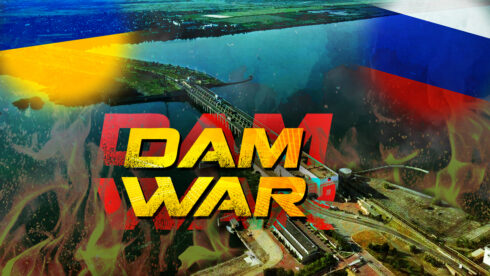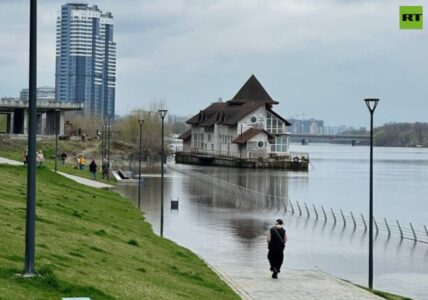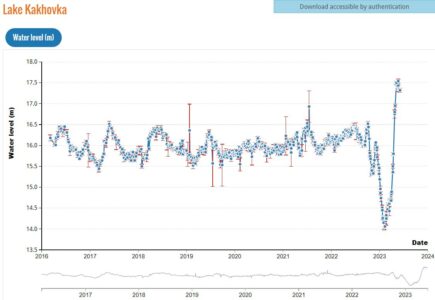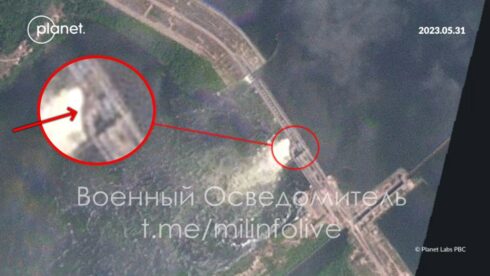It has been known for a long time that Kiev was preparation to destroy the dam in Novaya Kakhovka. A few months ago, it became obvious that the Ukrainian authorities were accumulating water upstream of the Dnieper River in order to flood the banks in the Kherson region at the beginning of a large-scale counteroffensive on the southern frontlines.
In the second half of April, the waters of the Dnieper surprisingly overflowed the banks in the Kiev region. The Ukrainian media, referring to the data of the Ukrainian Hydrometeorological Center, reported that the water had almost reached a critical level, explaining this with heavy precipitation. However, the water of the Dnieper in Kiev has not spilled like this over the past decades, while the spring of 2023 was not marked by particularly extraordinary rain, and the winter was not extremely snowy.
A similar situation was in the area of the Dneprodzerzhinsk (Kamensky) water reservoir in the Ukrainian Dnipropetrovsk region, where the river also overflowed its banks and flooded several settlements nearby. Local residents were evacuated. It turned out that the flood occurred because the local dam deliberately did not dump water for two weeks.
In the spring of 2023, the water level in the reservoir of the Kakhovka HPP was a record low since 2017, which confirms that the water was deliberately delayed upstream.
Even then, few people believed in Kiev’s fairy tales about heavy rains, and that it was the Russians who used weather weapons to kill as many Ukrainian civilians as possible as part of a fake genocide hysterically promoted by Ukrainian authorities.
In fact, back in April, military experts explained the connection between the accumulation of water and the long-awaited Ukrainian counteroffensive in the southern regions.
“In other words, the Ukrainian authorities deliberately accumulate water upstream in the controlled territory. If they open all the floodgates at the same time and drain the water, and the floodgates at the Kakhovka HPP controlled by us are damaged, then the left bank of the Kherson region controlled by us may be flooded.” – a military expert from the DPR Daniil Bessonov wrote on April 18.
The threat of the destruction of the Kakhovka dam by Ukrainian forces and the deliberate flooding of the southern banks of the Dnieper also became one of the reasons for the retreat of Russian forces from the west bank in Kherson region, the expert noted. If the dam had been destroyed then, the Russian grouping would have been cut off.
On the night of June 6, the dam at the Kakhovka HPP was finally destroyed. Moreover, videos from the region confirm that the shelling from the Ukrainian side continued in the morning hours.
As expected, Kiev is in no hurry to block the flow of water upstream of the Dnieper in order to reduce the damage to the affected region. On the contrary, the dumping of water at the Dnepropetrovsk HPP has reportedly increased. In an attempt to flood the positions of the Russian military, Ukraine decided to arrange a large-scale catastrophe.
The reservoirs has also been filled with extreme amount of water in the past time, as it was seen on the scheme above. Kiev intentionally began to drop water on the upstream dams on the eve of the attack.
Russian Defense Minister Sergei Shoigu claimed:
According to available data, the drop of water from the Dnepropetrovsk HPP has been significantly increased, which leads to even greater flooding of territories. This fact testifies to a large-scale sabotage planned in advance by the Kiev regime. The result of the undermining of the Kakhovka HPP will be long-term environmental consequences.
The increase in water drop was also reported by local Ukrainian sources.
At the same time, Kiev has begun the construction of defensive positions on the eastern bank of the Dnieper. This indicates the intention of the Ukrainian military to go on the defensive there, the Russian Minister explained.
Having failed to achieve success in the offensive, Kiev intends to transfer units from the Kherson direction to the area of offensive operations, thereby weakening positions in the Kherson direction.
The Russian side has repeatedly drawn the attention of the international community to the Ukrainian shelling of the Kakhovka HPP, Moscow expressed its concerns for the civilian population of the local coastal settlements and called for the Ukrainian regime to be restrained.
In October last year, the Russian Foreign Ministry, informed the UN Council on Kiev’s plans to destroy the dam, but there was no reaction.
In December 2022, the Washington Post also wrote that the Ukrainian military considered the possibility of damaging the Kakhovka HPP in order to raise the water level in the Dnieper to support the counteroffensive operations:
Then, Major General of the Ukrainian troops Andriy Kovalchuk, who was the commander of the “Ukrainian counteroffensive” in the Kherson region, claimed that it was not possible to attack on flat terrain because of minefields. In this regard, it was decided to raise the water in the Dnieper River in order to deprive the Russian troops of the opportunity to deliver ammunition and equipment to the battlefield.
According to him, the AFU even delivered a test strike from the HIMARS launcher at one of the locks at the Novaya Kakhovka dam, making three holes. It was allegedly necessary to make sure whether it was possible to raise the water level in the Dnieper enough to block Russian crossings, but not to flood nearby villages. However, such a step was allegedly considered an extreme measure.
In March 2022, the HPP suffered significant damage from Ukrainian fire. Restoration work under the blows of Ukrainian shells was not possible. However, the entire international community, represented by Kiev’s Western partners, did not care about the threat of a large-scale catastrophe.
Satellite imagery from early June also confirmed damage to the automobile bridge near the building of the engine room of the Kakhovka HPP. The water flow in the area has increased. The road was regularly fired from US-made HIMARS MLRS. It could not be restored easily and quickly, which was what the Ukrainian military was counting on.
As a result of the night shelling, the damaged spans collapsed. According to preliminary reports, the strikes were not carried out by Western weapons, but by Ukrainian MLRS Vilkha, which was enough. The use of HIMARS would be easier to confirm.
Kiev gains a military advantage from the destruction of the dam. The flooding zone primarily includes the eastern bank and islands, the territory that is under the control of Russian forces. The eastern shore is lower, a larger area is flooded there.
Due to the flood, the units of the Russian Army need to move their positions further and deploy new firing positions. Mine-explosive barriers, warehouses and fortifications located on the shore were damaged, not to mention the civilian infrastructure.
The transfer of troops must be carried out amid the ongoing fighting on the fronts in the Kherson and Zaporozhye regions.
Of course, the western coast of the Kherson region also suffers. However, given that the activity of the Ukrainian groups on the islands has significantly decreased in recent weeks, although it remained for distraction, it can be assumed that part of the Ukrainian military personell were redeployed to other front lines in advance. In the immediate vicinity of the water on the western bank of the Dnieper, there were the positions of several dozen military units and territorial defense forces of the Armed Forces of Ukraine. Some of them are transferred to the areas of the main offensive in Zaporozhye and in the South Donetsk direction.
After some time, the soil will dry out, after which the belligerents will be forced to re-occupy previously flooded positions. The AFU will try to take control of the Russian territory on the eastern shore at least in some areas to further expand the bridgehead.
Moreover, the Ukrainian Armed Forces still can attempt to cross the Dnieper and deploy pontoon crossings for the transfer of equipment, using special military equipment supplied by NATO countries. Attacks are facilitated by the destruction of Russian minefields.
A particular danger to the Russian defense is the possible attempts of the Armed Forces of Ukraine to cross the Dnieper upstream near the destroyed dam to strike in the Berislav-Novaya Kakhovka area. Also, the depth of the reservoir is much lower in the area of Energodar and the Zaporozhskaya NPP, which can allow the Ukrainian military to use light boats for assault operations. Another direction of the Ukrainian attack may be the Kinburn spit, where the fire control of Russian forces was significantly weakened. From the Black Sea coast, Russian artillery was firing Ukrainian military port of Ochakov.
The reinforcement of the Ukrainian grouping on the frontlines in the Zaporozhye region and in the south of the DPR, where the promised Ukrainian counteroffensive began, is still ongoing. After two days of massive attacks, Kiev does not give up its attempts to achieve at least some victories. On June 6, after several hours of pause, the AFU regrouped and began a new assault on positions in the village of Novodonetsky, which they had lost the day before.
It is obvious that the flooding of the region brought military advantages to Kiev. However, it was followed by the catastrophic destruction of the civil infrastructure in the Kherson region, which became part of the Russian Federation half a year ago.
3 settlements have already been completely flooded in the Novokakhovsky urban district on the eastern bank. In the town of Novaya Kakhovka, the river level has already reached 11 meters. Presumably, the water will arrive within the next 24 hours.
The destruction of the Kakhovka HPP will heavily damage agriculture in the Zaporozhye region. The reservoir will lose water necessary for irrigation. Local authorities reported that there will be some water in the local canals for only a month and a half.
The North Crimean canal, through which water entered the Crimean peninsula, was also drained. It was replenished only after the liberation of the Kherson region from the AFU. In 2014, Kiev blocked the canal to revenge the population of Crimea, who wished to reunite with Russia. Today, the Ukrainian authorities hypocritically complain that the peninsula was left without water. However, they have nothing to worry about. During the years of the water blockade, Russian authorities have provided the entire peninsula with the necessary water supplies.
Today, Kiev is taking revenge not only on Crimeans, but also on residents of pro-Russian Zaporozhye and Kherson regions with the shelling of the Kakhovka HPP.
The Ukrainian authorities reported that 150 tons of engine oil had entered the Dnieper and there is the threat of up to 300 tons of oil falling into the river.
The cooling system of the Zaporozhye NPP is under threat as well. The head of the IAEA, claimed that the water level for cooling the NPP is falling, but there are backup reservoirs. The representative of the nuclear power plant pointed that the water level in the cooling pond did not decrease.
Despite all the benefits for the Ukrainian regime, Kiev hypocritically accuses Russia of shelling the facility that is under its own control
The disaster has become another reason to demand the G7 countries and the EU to immediately impose new sanctions on Russia.
The hypocritical call on the UN Security Council meeting, as well as the dissemination of false and unsupported claims on the Ukrainian media, certainly led to the accusation of Russia by the West. However, Kiev’s efforts did not bring any results, since everyone understands well who is to blame. So Western leaders limited themselves to traditional statements.
- Scholz called the disaster a “new dimension” of the conflict and said Berlin would continue to help Ukraine.
- Stoltenberg claimed that the destruction of the dam once again demonstrates the brutality of the conflict between Russia and Ukraine.
- The head of the European Union also blamed Russia for the incident and pointed to bringing all those involved to justice.
- Similar statements were made by other leaders from the West.
No one provided any facts to accuse Russia. However, the West has never needed them to blame Moscow.
In October 2022, SouthFront wrote on the regular shelling of the Kakhovka HPP by Kiev forces LINK:
If the Ukrainians destroy the floodgates, the water will rush downstream and create a giant wave with a height of up to five meters which will flood the zone of more than five kilometers.
Kiev traditionally assures that it is allegedly Russia that is going to destroy the dam. Making such statements, Ukraine ignores both logic and objective facts. Cui bono? Who really benefits from such an event? The answer is clear.
The Kiev regime also ignores the fact that the Russian military has all the necessary means to destroy the Kiev Hydroelectric Station located near the capital. In a retaliation strike, Russia could completely divide Ukraine along the Dnieper River, destroying all the bridges and communication lines. As a result of the disaster caused by the destruction of the Kiev dam, more than 10 million people will suffer. But Russia could win the war “in one day”.
The scenario of the division of the Ukrainian region by natural factor, an overflowing river, would lead to the inevitable attenuation of the conflict, which is in the interests not only of Russia, but also of the West.









